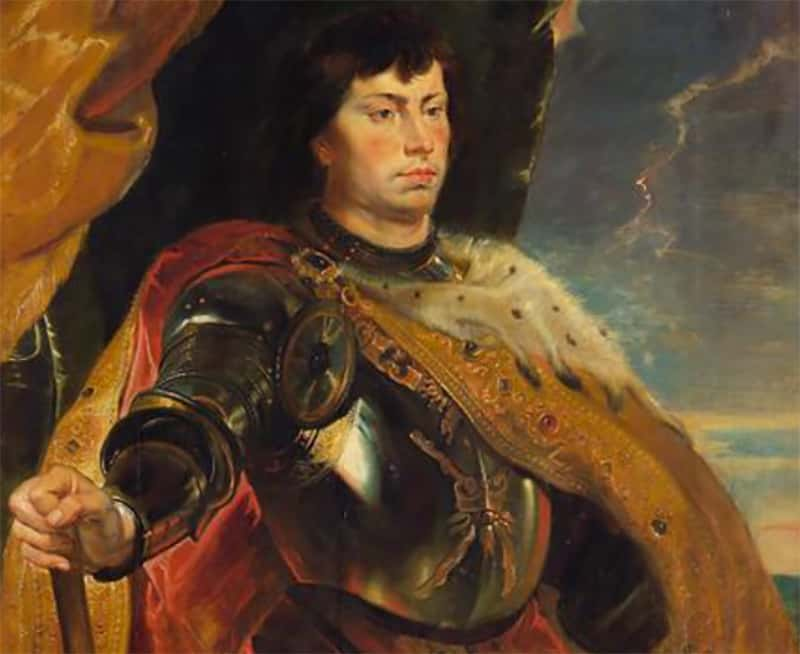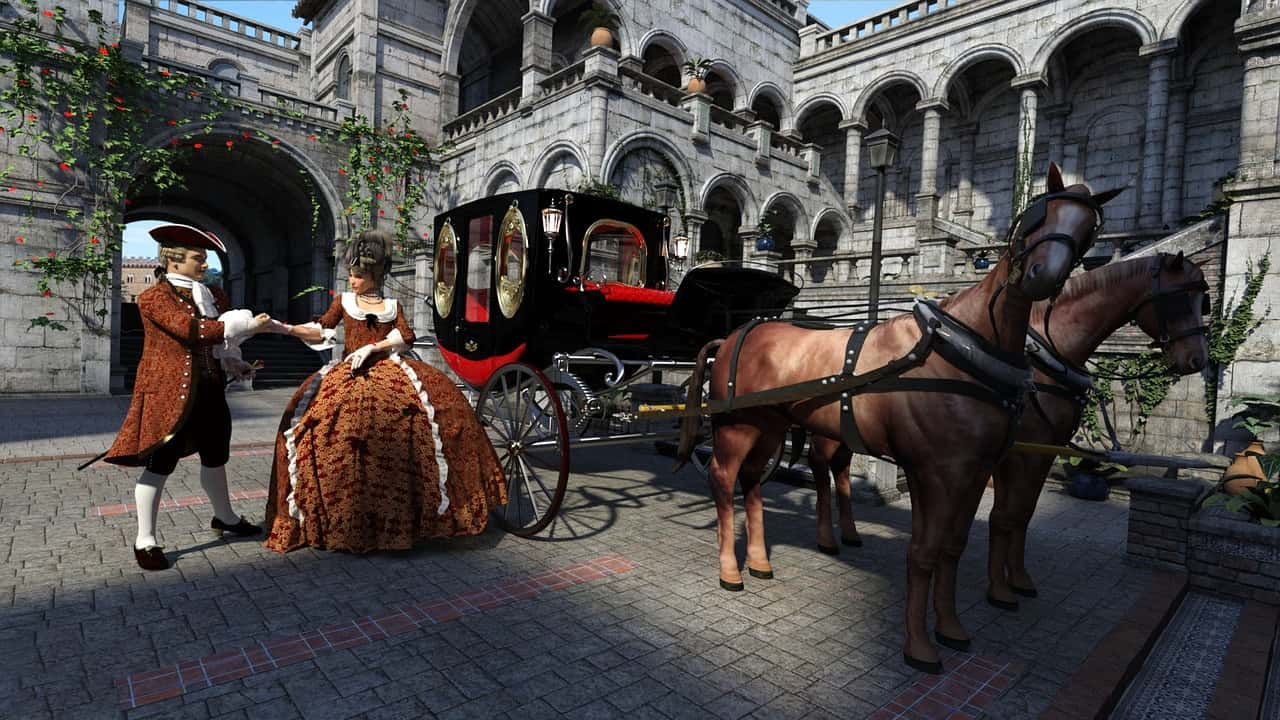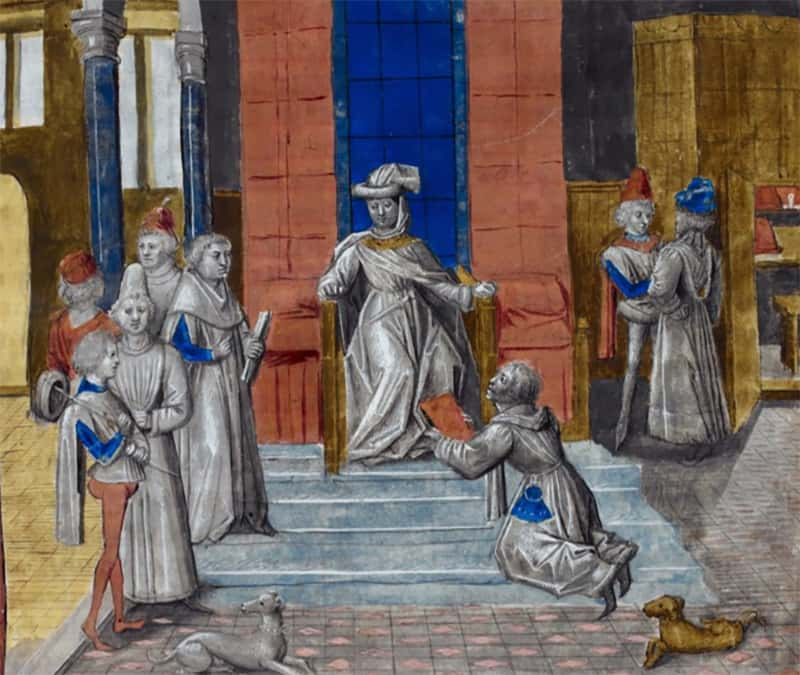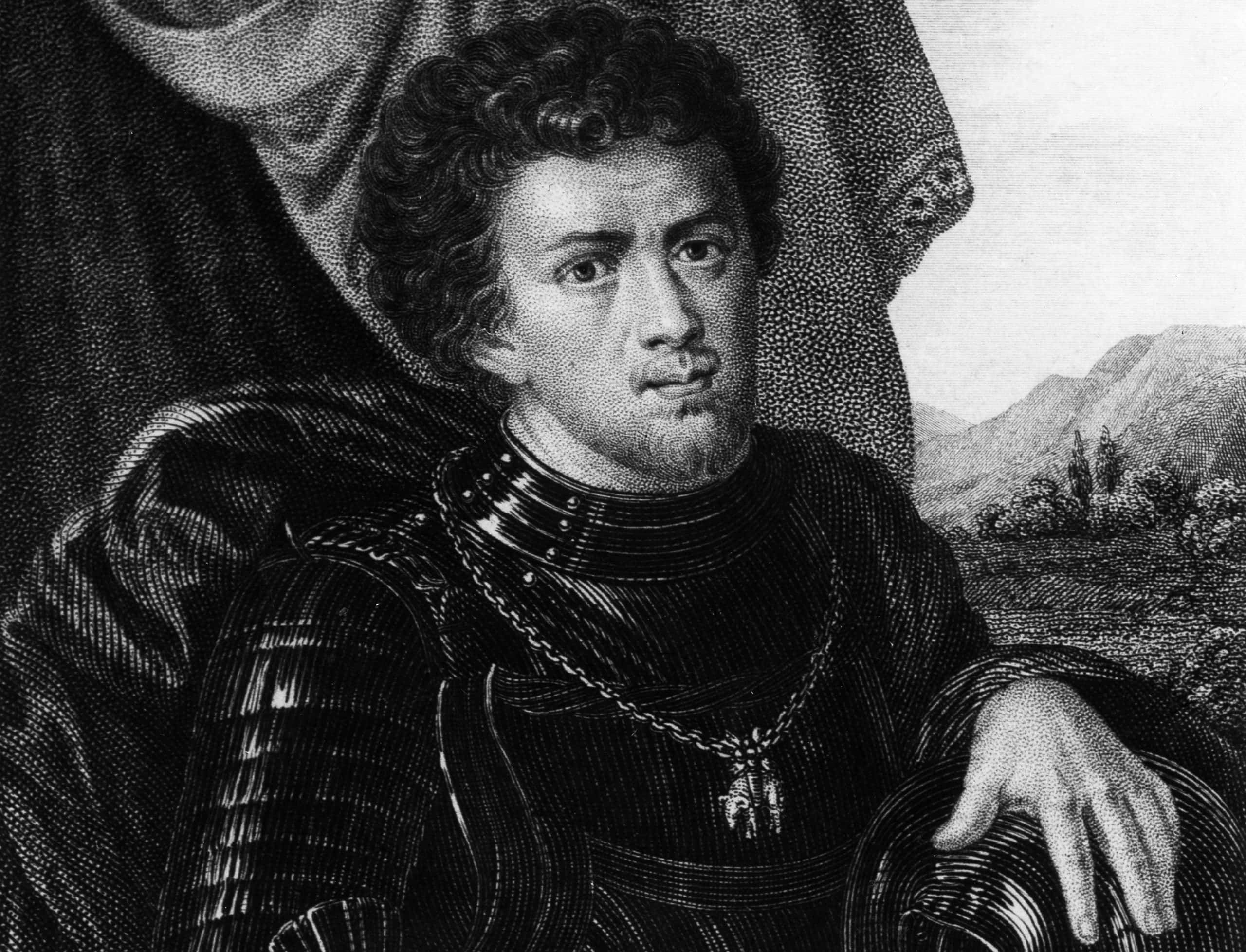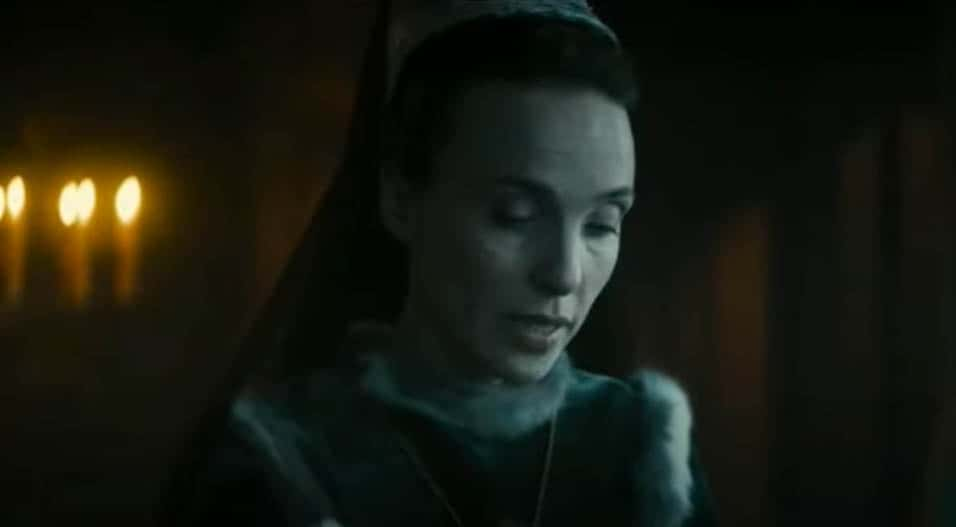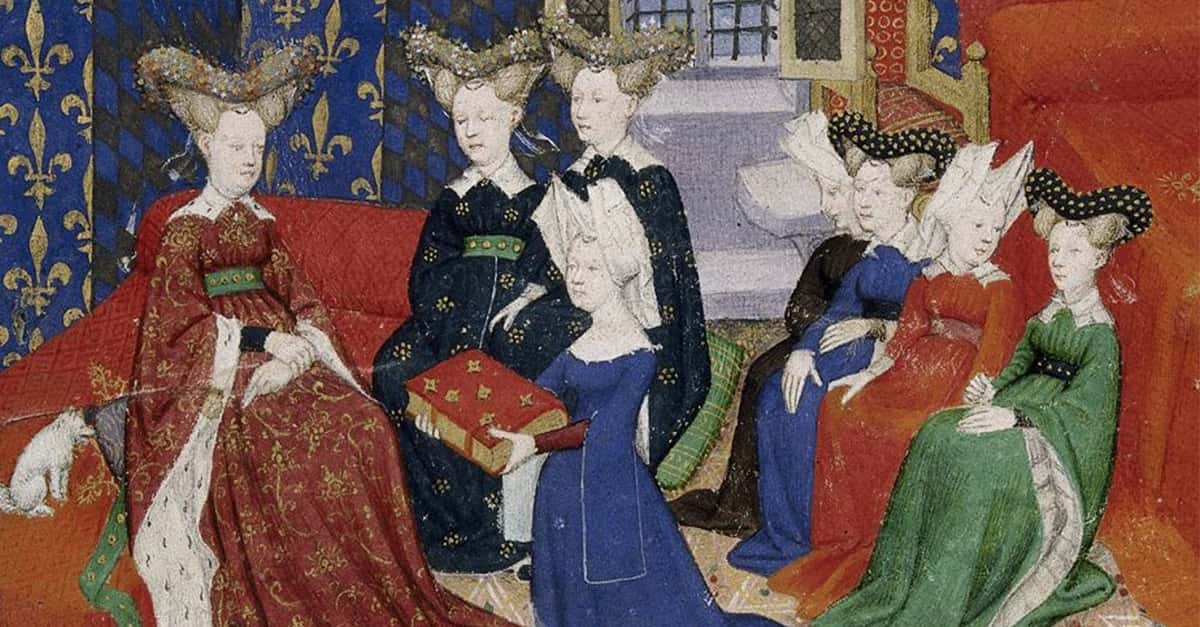Margaret of York married a Duke and two of her brothers were Kings of England at different times. However, just being associated with powerful men wouldn’t make her an important historical character if she had no achievements of her own. So, was she a devious duchess or an intelligent diplomat? How does history remember Margaret of York, and is that version justified? Let’s take a look at her life ourselves and find out who she was and what challenges she faced.
1. She Was Part Of A Large Family
Born in 1446, at Fotheringhay Castle in Northamptonshire, England, to Richard of York and Cecily Neville, Margaret was one of 12 kids. She was also the couple’s last surviving daughter. We don’t know a lot about her childhood, but we do know that her dad’s desire for the throne would impact his family life, and not in a good way either.
Another one of his goals: To make sure his daughter married up.

2. She Could Have Been A Child Bride
Her family might have not married her off right then, but they did try getting her betrothed when she was just eight. Richard of York became Duke and established himself as King Henry VI’s protector in 1454. He probably felt this was the best time to secure a nobleman for Margaret, and he didn’t have to look too far to find one.
 The Hollow Crown (2012– ), BBC
The Hollow Crown (2012– ), BBC
3. She Caught The Eye Of A Duke
The nobleman for Margaret was Charles the Bold, Duke of Burgundy. His mom, Isabel, wanted an alliance with the Yorks since she shared an ancestor with Margaret’s mom. Richard of York was delighted, as Burgundy was a rich and cultured region. Sadly for him, Charles’ dad wanted a French daughter-in-law. Looks like Margaret was out of luck—or was she?
Some marriages are just meant to be, and as we’ll see, this would prove to be one of them. Before that happened though, Margaret and her family faced a devastating incident.
4. She Faced A Tragedy
Margaret’s dad badly wanted to become king, and he tried to achieve this goal at the Battle of Wakefield when she was just 14. Unfortunately, he lost not just the battle, but his life too. Even darker, his opponents decided Richard of York deserved worse than an honorable end on the battlefield. They beheaded him and placed his head atop the walls of their home city of York. And as a final humiliation? They placed a mocking paper crown on his head for daring to challenge the throne. Brutal.
Oh, and one of her brothers also lost his life in the same battle. The House of York was at its lowest point—but they wouldn't be there for long. Eventually, the kingship her dad had sought so eagerly would come to her older brother, and this would mean brighter days for Margaret of York as well.
5. She Spent Some Time At Court
After her brother became King Edward IV, Margaret followed him to court and was present at his queen’s coronation as well. Since her older sisters already had husbands to support them, her brother paid for her lifestyle out of the royal treasury. But Margaret of York couldn't hope to remain single for much longer. She was an accomplished, educated young princess and had several suitors interested in claiming her hand. And whoever won her hand was in for quite a handful...
6. Her Appearance Sparked Some Speculation
Margaret was tall, at almost six feet. She was blonde, grey-eyed, and looked like her older brother, King Edward IV. They were a pair of 10s, but their appearance led to some scandalous rumors. People compared their looks to their dearly departed father, Richard of York, who was short and dark-haired. Courtiers were hopeless gossips back then, and many people were convinced he wasn’t their real father.
There's no proof of that historically—but there was still a betrayal in store for the House of York.
7. The Rumors Weren’t Pleasant
Always trust your family to really screw things up. Apparently, Margaret’s mother Cecily Neville had it in for her son Edward, mainly because he had married a lowborn woman named Elizabeth Woodville, rather than agreeing to a political match. To make matters worse, Woodville was a widow with two kids. The absolute horror!
In petty revenge, Cecily didn’t do much to negate the rumors about her children’s illegitimacy, throwing Margaret right under the bus in the process. How very Cersei Lannister of her!
8. He Put A Ring On It
Despite this family feuding, the Yorks still knew they needed to get their daughter married. Margaret’s engagement took place when she turned 20. The lucky suitor was Peter, Constable of Portugal, also Charles the Bold’s cousin. Unbeknownst to the Yorks, their future son-in-law was pretty overwhelmed by his duties, and not in the best of health when he proposed.
Peter may have become king of the Catalans as well as Margaret’s husband, but it turned out he wasn’t that lucky after all.
9. It Was A Short-Term Affair
Sadly for Margaret, her fiance didn't handle stress very well. So much so that he didn’t wait for either the engagement or the proposed kingship to get to the next step. The man’s heart gave way before that, and he passed just a few months after the betrothal. I doubt it broke Margaret up too much though—she'd never even met the guy! Plus, she wouldn’t have to wait long for another eligible suitor to appear.

History's most fascinating stories and darkest secrets, delivered to your inbox daily.
10. Mr. Right Finally Found Her
Clearly, Margaret and Charles the Bold were meant to be together, but they had a dramatic "Romeo and Juliet" story before that happened. Obviously, they had almost been betrothed when they were children, and Margaret had fully been engaged to another man, but that wasn’t their only hurdle. When Margaret turned 20, the stars finally seemed to align for the couple.
They got Edward to support their match, and everything appeared to be in place—only for another enemy to enter the ring…
11. Not Everyone Desired Her Marriage
Although Edward IV was now ready to accept Charles the Bold as his brother-in-law, Margaret’s troubles were far from over. The French king, Louis XI, was unhappy about the match. And he didn’t just show his displeasure by mentioning his concerns to the prospective groom. On the contrary, he actively did everything he could to ensure the wedding’s cancellation.
And by everything, I mean everything! They didn't call Louis "The Universal Spider" for nothing. He was willing to play dirty.
12. His Plans Did Not Succeed
Note: Do NOT get on a French King's bad side. From calling upon the Pope to forbid the wedding on the basis that Margaret and Charles were distant cousins, to trying to discredit Edward to his bankers so he wouldn’t be able to pay for his sister’s dowry, Louis XI tried his best to stop the couple from getting married. Luckily for them, all these efforts were in vain.
But did Louis give up? Oh no. He had one final, cruel trick up his sleeve.
13. He Made A Last-Ditch Effort
Since nothing else had worked, Louis XI came up with another brilliant idea to stop the wedding. He slandered Margaret, claiming she’d been involved with another man and had an illegitimate child hidden somewhere. Thankfully, Charles the Bold was no Othello and paid no heed to this accusation. Then, when Margaret set off to meet her groom at long last, Louis XI ordered his ships to seize her before she crossed the English Channel.
Again, thankfully, the people manning the ships had more integrity than the French king, and she was able to get to her groom-to-be without any trouble. It finally seemed like her trials were over. Unfortunately, they were not.
 Flickr, Ann Longmore-Etheridge
Flickr, Ann Longmore-Etheridge
14. She Met Her Match
Margaret met Charles at long last. The meeting they waited so long for was no fairy tale. At 22, she was 13 years younger than him, but at almost six feet, she was quite a bit taller. In fact, she had to bend down to kiss him. Still, what Charles the Bold lacked in stature, he made up for in status. He may not have been king, but he was a very powerful Duke.
So when Margaret arrived at his doorstep, she let loose.
15. She Found A Sisterhood
Margaret’s new mother-in-law, Isabel, and stepdaughter, Mary, were extremely welcoming of the newcomer, and she was always very close to them. Mary was Charles’ only child from his second wife; he had never really known his first wife since he was just a child when he married her. Margaret immediately took a liking to Mary and would always treat her like her own daughter. But the ladies weren’t the only ones delighted to welcome Margaret.
16. She Became A Duchess
Margaret and Charles married each other in a private, early morning ceremony, a week after they’d met. Although they didn’t have many people attending the actual wedding, the real celebrations would happen when the bride and groom made their grand entrance among their people. That's when the real party started.
17. She Received A Rousing Welcome
Charles traveled to Bruges soon after the wedding, and Margaret followed a few hours later with her own entourage in a grand procession. The couple made their royal entrance into society, AKA "Joyous Entry," amidst much festivity and partying. Everyone knew the Burgundians enjoyed extravagance, but they surpassed all previous standards by hosting a welcome more spectacular than anything seen before.
18. She Enjoyed The Attention
Margaret of York basked in the attention and love she seemed to command from her new subjects. She drove through the streets in the pouring rain, in her golden litter drawn by white horses, waving to the people instead of shutting herself in from the wet and windy weather. Flowers and torches adorned the streets, and sculptures of archers spurted spirits for the revelers.
The wedding and welcome went down as "the marriage of the century". Its reenactment in Bruges remains a tourist attraction to this day, which you can catch every five years. The next reenactment is due in 2022 by this token.
19. Her Crown Was Spectacular
The Duchess and Duke both wore splendid crowns at their welcome ceremony. Pearls and white enamel flowers adorned Margaret’s crown. These flowers were a symbol of the House of York (in the Wars of the Roses, the White Rose represented the House of York). It also had her name in Latin, set in red, green, white, and gold. The crown is significant because it is one of only two medieval royal crowns that survive to this day, as Parliamentarians destroyed all the others during the rise of Oliver Cromwell.
20. She Didn’t Mind Travel
Margaret knew that every good ruler needed to stay in the public eye. She traveled through several regions after Bruges. Her husband realized that his wife was interested in how he ruled, and she was quick to understand what he told her. However, Charles soon discovered that intelligence wasn’t something that ran in her family.
21. Her Brother Made A Mistake
Margaret may have been a sharp cookie herself, but you couldn’t say the same for her brother Edward IV. For starters, he made a disastrous mistake when he presented Charles with the Order of the Garter. To be sure, it was one of England’s highest honors, but if Charles had accepted it, French King Louis XI would have charged him with high treason.
Thankfully, Charles’ mother preempted the disaster and her son refused to accept the honor. But this wouldn’t be the last time Margaret’s brother would trouble them.
22. She Sided With Him
When Margaret discovered that her younger brother, the Duke of Clarence, and cousin, the Earl of Warwick, had conspired to overthrow Edward IV, she asked Charles to stand by him and help him regain the throne. Initially, Charles agreed and threatened London merchants that they’d lose Burgandian business if they didn’t stay loyal to Edward.
While this briefly brought Edward back to power, his downfall was still coming...and Margaret was right in the middle.
23. Her Worth Lessened
Look, Edward just wasn’t a popular guy, and less than a year later, yet another plot had him abandoning his throne, fleeing to Flanders, and looking to his sister and Charles for help. It didn’t go quite the way he planned it: While Margaret still stood by her brother, her husband Charles was less convinced, and he only helped reinstate Edward to the throne after deciding it would benefit him too.
Margaret didn’t appreciate her husband's indifference, but that wasn't the only thing causing her distress. Even without her brother's misadventures, Margaret of York had a massive problem.
24. She Realized She Had A Problem
Margaret may have been Charles’s third wife, but she felt the responsibility to provide him with a son and heir quite keenly. Imagine her disappointment when months turned into years and she was unable to fulfill this important "duty". The woman didn’t leave any stone unturned though. She even visited shrines and churches, hoping prayer would help if nothing else did.
Eventually, she had to accept the heartbreaking truth. She'd never have a child of her own.
25. She Directed Her Energies Elsewhere
Margaret had gotten along well with her stepdaughter Mary from the first time they met, and that bond only grew. They both seemed to enjoy the same things, like hunting, reading, and writing. They also shared a love for falconry, and Margaret took over the responsibility for Mary’s education. Either because of this, or because he was a matter-of-fact person, Charles did not openly blame Margaret for not giving him an heir.
However, behind the scenes, there was trouble in paradise.
26. She Hardly Met Her Husband
Historical records seem to prove that as time went on, Margaret and Charles hardly spent any time together. He visited her fairly regularly for the first four years of their marriage, but the visits grew more infrequent in the next three years as Margaret didn’t seem able to get pregnant. Scholars estimate that they spent a total of one year together in those first seven years, and then he stopped visiting almost entirely. But hey, Margaret didn’t take this lying down.
27. She Gradually Took Control
In the first few years of her marriage, Margaret didn’t bother herself with state affairs at all. However, she suddenly found herself with a whole lot of time on her hands, and she began to understand her role and became an important administrator of Burgundian affairs. She was also a great representative for the Duke when he was away, trying to conquer new territories. It helped that she had a great role model.
 The White Princess (2017), Starz!
The White Princess (2017), Starz!
28. She Had A Good Teacher
Margaret had enjoyed a good relationship with mother-in-law Isabel since she met her. She observed how the Dowager Duchess received diplomatic missions on her son’s behalf, and how he depended on her advice in his political affairs. Isabel shared her wisdom and helped Margaret become a politically savvy survivor in a world rife with plots and conspiracies. But it wasn’t just advice Margaret got from Isabel...
29. She Made People Love Her
Margaret of York was good at cultivating relationships. Her mother-in-law cared for her deeply and showed it by leaving her favorite residence to Margaret in her will. Yet while this was financially good for Margaret, losing Isabel left an emotional scar—and not just on her.
30. Her Husband Wasn’t Gaining Any Fans
Isabel’s passing had a disturbing impact on Margaret’s husband Charles. Sure, the man was probably devastated to lose his mom, but instead of just grieving over the loss, he seemed to be taking it out on other people. Everyone felt that Charles the Bold was becoming more Charles the Tyrant after the tragedy. He imagined threats from all quarters and his people dreaded his treatment of both real and imagined "rebels".
As you can imagine, this wouldn’t end well for him.
31. He Flew Too Close To The Sun
To Margaret’s dismay, Charles wanted to form a new kingdom, from the North Sea to the Mediterranean, and he felt he could achieve this by conquering all that territory. In other words, he was constantly away at battle. This did nothing to endear him to his people, or the neighboring regions. To make matters worse, the French King Louis had undermined his banking credit and reputation through trade embargoes.
Charles the Bold was playing a dangerous game—and he paid for it in the end. When Margaret met her husband again in 1474, it would be the last time they were together.
32. He Left Her In Charge
Duke Charles the Bold met his end at battle in 1477. But just before his passing, he left Margaret one last task to fulfill. He had arranged his daughter Mary’s engagement to Maximilian of Habsburg, and he expected Margaret to protect Mary’s marital interests and make sure Louis XI didn’t usurp them in his favor. Based on what we know of Louis, that would be no easy task.
 The White Princess (2017), Starz!
The White Princess (2017), Starz!
33. She Faced A Huge Challenge
With Charles gone, Louis XI dealt Margaret and Mary a devastating blow by taking over the Duchy of Burgundy for himself. His reasoning: A woman couldn’t inherit the Duchy. Now all the women could do was make sure that Burgundy didn’t get further divided, so Mary had enough power to stay relevant. But if you think Margaret was beaten, you've got another thing coming.
 The White Princess (2017), Starz!
The White Princess (2017), Starz!
34. She Safeguarded His Legacy
Determined not to let Louis further encroach on Burgundy or her family, Margaret wrote to Maximilian to visit them immediately, hoping his power and protection could combat the King of France. But, knowing that that might not be enough, Margaret made sure to sweeten the deal with a brilliant and dangerous move.
 The White Princess (2017), Starz!
The White Princess (2017), Starz!
35. She Schemed With The Best Of Them
In order to entice Maximilian to be the strongest, most devoted ally against the Kingdom of France he could be, Margaret drew up a marriage contract that made a huge promise: In the event of Mary’s passing, Maximilian would receive her full inheritance, AKA, the Duchy of Burgundy. As we’ll see, this provision would prove to be critical.
36. She Wasn’t Going Anywhere
By now, Louis XI realized that he had a strong adversary in Margaret. Before long, he tried to buy her off with a French pension and a promise that he’d personally protect her. It would have been a sweet deal—for anyone other than Margaret of York. She scoffed at his offer and sailed off to England to negotiate her affairs. She was happy being a wealthy widow, and one of Mary’s most trusted advisors.
She was going to bet on herself—and it paid off in the end.
37. She Became A Grandmother
In 1472, Mary of Burgundy gave birth to a son, Philip. When the boy's christening came, she entrusted none other than her beloved stepmother, Magaret of York, to carry the child. Two years later, Mary made an even more heartwarming gesture: She named her second child, a daughter, Margaret. After so much hardship, things finally looked good for Margaret of York—except just as the happy family was all coming together, an old rival showed up.
38. Her Old Enemy Came Back To Haunt Her
Louis XI just couldn’t let sleeping dogs lie—or, as it happened, sleeping babies. Staying true to his slandering ways, the French King spread the rumor that the Burgundian heir Philip was actually a girl, and so couldn’t inherit the duchy when he came of age, thanks to the laws that Louis himself had just so happened to put in place. Now, our girl Margaret couldn’t take this rumor lying down.
 The White Princess (2017), Starz!
The White Princess (2017), Starz!
39. She Liked Creating A Stir
In true boss fashion, Margaret countered the rumor the only way she knew how: by undressing Philip in front of the crowd gathered for his Christening, thus proving beyond a doubt that he was actually a boy. I’m thinking it’s a good thing this wasn’t a time of cell phones and social media, ‘cos Philip might not have appreciated a photo of that little incident floating around.
Margaret proved herself a vital ally to her stepdaughter and Emperor Maximilian—and in more ways than one.
40. She Was A Great Mentor
Apart from providing Mary and Maximilian with political advice, Margaret was invaluable in helping them raise men and money to battle France. Earlier, after Charles’s passing, she’d even asked her brother Edward to send his men to prevent Louis XI from taking any more of their lands. For all this hard work, Mary repaid Margaret by letting her keep all the rights and properties she enjoyed while Charles was alive.
It was a kind gesture from a loved one—but another devastating loss was just on the horizon.
41. She Faced A Huge Tragedy
By the 1480s, Margaret had lost many people from her family. Her father, two brothers, her husband, and her mother-in-law. But no loss was as heartbreaking as when she lost Mary, the girl she’d always considered her daughter...and in the most brutal way imaginable. In 1482, while out falconing with her husband and his knights, Mary's horse suddenly tripped and threw her in a ditch.
The retinue panicked, but that was just the beginning of the nightmare.
42. She Lost Her Daughter In A Horrific Way
After she launched into the ditch, Mary’s horse fell on top of her and broke her back. Margaret’s 25-year-old beloved stepdaughter managed to cling onto life for a few more weeks, until she finally expired on March 27. Margaret was stricken with grief, but she didn't have time to mourn. She immediately understood that her lands were now in more danger than ever...and she had work to do.
43. She Had To Scramble For Power
The next years of Margaret’s life saw her desperately clinging to any power she could find. King Louis still held her feet over the fire; Margaret even eventually sent her two-year-old granddaughter, the little Margaret, over to France in the hopes of pleasing the King and preventing him from further encroaching on her territories. Meanwhile, Margaret put all her focus into raising her grandson.
Her world upside down, Margaret held on for dear life—and right at that moment, another sudden loss threw everything into chaos once again.
44. She Saw Another Loss
While Margaret was busy raising the little Duke-to-be, Philip, things changed drastically in England. Her brother, Edward IV passed, and her younger brother, Richard III, declared his nephews illegitimate and took over the throne himself. There isn’t any record of Margaret’s reaction to this development, but she probably supported, it as it made political sense for Burgundy.
But things would change again for her, and sooner rather than later too.
45. She Didn’t Like The New King
Sadly for Margaret, Richard III, who was also her last surviving brother, didn’t live too long either. He lost a battle to Henry Tudor, who went on to become Henry VII, the next King of England. This change in rulers brought about an end to the trading privileges that the Yorks had granted Burgundy. Naturally, Margaret didn’t appreciate that at all and, as she always did, she fought back.
 The White Princess (2017), Starz!
The White Princess (2017), Starz!
46. She Opposed Him Actively
Margaret did all she could to oppose Henry VII and get him off the English throne. She supported men like Lambert Simnel and Perkin Warbeck, hoping that one of them might be able to take over the throne. She even claimed that Warbeck was her missing nephew, and there is speculation that she may have actually believed it to be true.
Her support couldn’t muster up enough backing for these two pretenders, however, and Henry VII was able to banish and execute them without much trouble. Margaret had run out of ways to fight back.
 The White Princess (2017), Starz!
The White Princess (2017), Starz!
47. She Put Up A Stoic Front
Henry VII eventually returned Burgundy their trading privileges and signed a treaty with them. One of the main clauses was to forbid Margaret from supporting any of his enemies. It seems that by then she had lost steam, and the will to overthrow him, so she agreed to the clause. Perhaps she also agreed because some happier events—all too rare at this point in her life—distracted her.
 The White Princess (2017), Starz!
The White Princess (2017), Starz!
48. Her Granddaughter Returned To Her
Margaret’s step-granddaughter returned to her in 1493, a year before her older brother Philip came of age. In celebration, Margaret planned a great double wedding for both her grandkids the following year. Philip would marry Joanna of Castile and young Margaret would marry Joanna’s brother. It seemed like Margaret would finally fulfill the promise she’d made to Mary to take care of her children.
49. Her Grandson Appreciated Her
When Philip came of age in 1494, he inherited his mother’s lands and titles. He acknowledged his grandmother’s service and love and looked up to her for advice. Margaret in return played an important role in selecting officials and administrators, and in presiding over important ceremonies, such as his children’s christenings. All that was left to do was for Margaret to go out with a bang.
50. Her Story Came To A Sudden End
Margaret passed suddenly in 1503, when she was only 57. There is no record of any illness, so her passing was unexpected. The Monastery of the Recollects in Malines became her final resting place, but her tomb could not survive the 16th century’s religious turmoil. Supposedly, it bore the inscription, "A marvelous and devoted patroness of justice, of religion, of reform".












